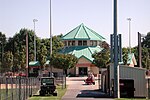Delta Park/Vanport station

Delta Park/Vanport is a light rail station on the MAX Yellow Line in Portland, Oregon. It is the 9th stop northbound on the Interstate MAX extension and is in the area of Delta Park, formerly the site of the city of Vanport. It is located between Portland International Raceway on the west and Interstate 5 on the east and is at the north end of the Vanport Bridge, which spans the Columbia Slough and an industrial area. The station platforms are to the sides of the tracks. Beyond them are two park and ride lots to the west and bus bays connected to an I-5 off-ramp to the east. As of 2018, one C-Tran bus route and one TriMet bus route serve this station. Artwork at the station references the 1948 Vanport Flood, even utilizing bronzed artifacts found on the construction site.
Excerpt from the Wikipedia article Delta Park/Vanport station (License: CC BY-SA 3.0, Authors, Images).Delta Park/Vanport station
North Expo Road, Portland Kenton
Geographical coordinates (GPS) Address Nearby Places Show on map
Geographical coordinates (GPS)
| Latitude | Longitude |
|---|---|
| N 45.596111111111 ° | E -122.68555555556 ° |
Address
Delta Park/Vanport
North Expo Road
97217 Portland, Kenton
Oregon, United States
Open on Google Maps






